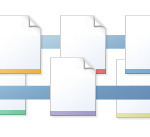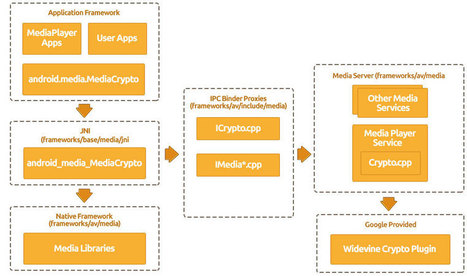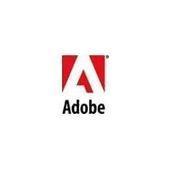 Your new post is loading...
 Your new post is loading...
Now Azure Media Services allow you to deliver Http-Live-Streaming (HLS) and Smooth Streams encrypted with Advanced Encryption Standard (AES) (using 128-bit encryption keys). Media Services also provides the key delivery service that delivers encryption keys to authorized users.
Azure Media Services also provides a Microsoft PlayReady license delivery service. PlayReady is a full-featured content access protection technology developed my Microsoft that uses Digital Rights Management (DRM). It protects a content media stream during playback by using a license server that provides the decryption key needed to decrypt the media stream. Firstly, you need to pre-encrypt Smooth Streaming file with PlayReady License, by providing us License Acquisition URL, Key ID and Content Key. You could follow this MSDN article to use Azure Media Encryptor to encrypt the Smooth Streaming file. As a output, you could further package the encrypted Smooth Streaming into HLS and DASH (See how here). You could also define how the license could be authorized to your user. Similar to AES dynamic encryption, we enable Token/IP/Open authentication service.
Which platform/devices that PlayReady SDK covers?Azure Media Services can be used to encode, download, or stream Smooth Streaming or MPEG DASH content encrypted with PlayReady. For consuming PlayReady encrypted content, client SDKsand the PlayReady Porting Kit are available under commercial licensing terms. (PlayReady clients for Windows 8.1 Store Apps can be built using the free SDK located HERE). These client-side SDKs are not part of this preview.
Intertrust Technologies has introduced an integrated content protection solution-as-a-service that it says is simple and cost-effective to implement by any service provider yet strong enough to protect high-value entertainment and media content including video, audio, ebooks and games. Called ExpressPlay, it works with existing Marlin-enabled Smart TVs and set-top boxes and with iOS and Android apps. Intertrust also provides an embedded SDK for device manufacturers and a content packager for service providers to ingest content. ExpressPlay supports Marlin and media streaming standards such as DASH and HLS.
It's all about DASH: Adoption is moving at a rapid pace, as industry insiders see a strong need to get DASH implemented in the field in the coming year. The Pantos spec, as it is known in the industry, is a series of working drafts for HLS submitted by two Apple employees as an information draft for the Internet Engineering Task Force. As of the time of this article, the Pantos spec is currently at informational version 10. Much has changed between the early versions and the most recent v10 draft, but one constant remains: HLS is based on the MPEG-2 Transport Streams (M2TS), has been in use for almost 2 decades, and is deployed widely for varied broadcast and physical media delivery solutions. In that time frame, however, little has changed for basic M2TS transport stream capabilities. For instance, M2TS still lacks an integrated solution for digital rights management (DRM). As such, all HLS versions cannot use "plain vanilla" M2TS, and even the modified M2TS used by Apple lacks timed-text or closed-captioning features found in more recent fragmented elementary stream streaming formats. Yet Apple has been making strides in addressing the shortcomings of both M2TS and the early versions of HLS: In recent drafts, the HLS informational draft allows for the use of elementary streams, which are segmented at the time of demand rather than beforehand. This use of elementary streams means that one Achilles' heel of HLS -- the need to store thousands, tens of thousands, or hundreds of thousands of small segments of long-form streaming content -- is now eliminated. Google, with its Android mobile operating system platform, has adopted HLS for Android OS 4. Some enterprising companies have even gone back and created HLS playback for earlier versions of Android OS-based devices.
Helix v15 offers DASH support for both live and on-demand profiles. More interestingly, it will also offer support for both ISO Base Media File Format (ISO BMFF, or fragmented MP4) as well as MPEG-2 Transport Streams (M2TS). The Helix Client SDK for Android can be used in Android applications to create an end-to-end delivery solution that includes the Helix server and a client app. Interestingly, the Helix SDK can be used to deliver HLS content to Android OS 2.2 and higher. Google has added integral support for HLS in Android OS version 3 or higher, but has not addressed the larger addressable market of pre Android OS 3.0 devices. Finally, Helix has digital rights management (DRM) support for a number of device types, including devices based on several key operating systems: Android, iOS, Mac, and Windows. Real's DRM leans heavily on Verimatrix's DRM solutions, using Verimatrix VCAS for HLS devices—via the ViewRight plug-in—as well as the ViewRight Client on PCs and set-top box devices. In addition, Real says that PlayReady support should be available in an upcoming dot release. HELIX SDK for Android : http://www.realnetworks.com/helix/helix-sdk.aspx
Adobe's updated media server takes the focus off Flash and offers enhanced HLS support. But what about DASH? With the ship date just around the corner, what features will make AMS 5 different from FMS 4.5 for Adobe's target customer base? Towes provided a list that highlights Adobe's continued support for Apple's HTTP Live Streaming (HLS) for iOS devices: - Protected HLS support via a content license technology embedded in AMS - Additional digital rights management support for HLS using Adobe Access 4 licensing server (a separate purchase) - The ability to segment HLS content for on-demand playback, using an offline HLS segmenting tool, which also supports encryption via Adobe Access 4 - Improvements for HTTP streaming failover and fault toleranceEIA-608 (line 21) closed caption support that will meet FCC requirements Finally, what about MPEG-DASH support? "Adobe is committed to supporting DASH in AMS in the future," says Towes. "Adobe has committed that our video streaming products will support MPEG-DASH, and we were one of the first companies to publicly demo DASH support at NAB this year, but we have not announced a timeline.
Input media formats: - Smooth (VoD & Live). An adaptive HTTP format specified by Microsoft. Used by Microsoft in Silverlight, but is an open format that third party clients also support. - Apple HLS (VoD & Live). An adaptive HTTP format specified by Apple. Used by Apple in iPhone/iPad, but is – like Smooth – an open format. - MPEG DASH (VoD). A new adaptive format specified by ISO. Wide and promising industry backing. We support both MPEG-2 TS and MP4-based (ISOBFF) profiles.
Input DRM formats:
- Microsoft PlayReady DRM
There are basically two ways to sustain the extensive growth of video formats that you must, as a media distributor, serve to your different clients’ target devices : the most common answer is to choose the best in breed most-powerful encoders to prepare all the target formats during the content preparation time (see Panorama article N°1 on this topic), but you can adopt a different approach saying that you want to prepare your contents once and have the distribution part of the overall workflow take care of the repackaging and protection of the contents on the fly.
Server-side repackaging of the streams consists eventually in :
- choosing languages in audio and subtitle tracks available in the original mux (optional)
- transcoding/transrating the video content in different sizes/bitrates from a high quality video file (optional)
- applying a DRM compatible with the output format (optional)
- generating the manifest file corresponding to the target adaptive streaming technology (mandatory)
- remuxing and chunking the video data according to the output protocol requirements (mandatory)
Historically, repackaging was pushed as a quick solution for broadcasters to add iOS streams on top of existing Smooth or Flash streams. In a wider OTT/Adaptive Bitrate perspective, this alternative approach means : less files to manage in the main production workflow, less storage, less bandwidth to populate the origin servers, smaller time to contents’ online availability and easier support for new formats – shortly said, an agile path.
Potentially a risky one, but quite attractive…
Let's examine the available options on the market, to do it on your own platform or in the cloud !
|
Android has limited support for HLS (Apple’s HTTP Live streaming protocol), and device support is not the same from one version or one device to the next. Android devices before 4.x (Gingerbread or Honeycomb), do not support HLS. Android tried to support HLS with Android 3.0, but excessive buffering often caused streams to crash. Devices running Android 4.x and above will support HLS, but there are still inconsistencies and problems.
StreamingMedia.com readers first heard about Adobe Primetime in February 2012, when Adobe announced the project and made the first parts of it available at that year's Mobile World Congress. Fourteen months later, Adobe is announcing the general availability of Primetime at the NAB conference. Primetime is a comprehensive modular tool for broadcasters streaming content online, and it includes components for distribution, ad insertion, DRM (digital rights management), and analytics. Because the platform is modular, broadcasters are free to choose the elements they need. They can also connect Primetime to other ad servers or analytics tools, if they prefer. Adobe's goal in creating Primetime was to help broadcasters further their reach, keep viewers engaged for longer, and help them monetize that reach and engagement. Adobe aims to keep distribution simple by letting one player and one workflow deliver video to all platforms. Primetime streams HLS video, which plays in a Flash player on the desktop. For now, Primetime supports live, linear, and on-demand video on Windows and Mac desktops, as well as iOS and Android mobile devices. Adobe announced that later this year it will expand support to include HTML5 on mobile devices, Roku, Xbox, and connected TVs. With this release, Adobe has also announced that Adobe Analytics (the new name for SiteCatalyst) is integrated with Primetime and offers granular data on individual viewer experiences right down to the 10-second level. Adobe Analytics is integrated into Primetime's media player.
Here is a How to, the objective is to demonstrate the setup of a PHLS live stream. PHLS means Protected HLS : the custom format of HLS by Adobe. The protection is realized with a AES-128 encryption on the content. To make this configuration, you need a streaming server which will push content via RTMP. Some live transcoders are available from ElementalLive to ffmpeg. And you need too a Adobe Media Server installed to complete this how to. All I write in this post is available via the AMS documentation.
Intertrust Technologies Corporation today released Wasabi Express, a standards-based next generation DRM platform for mobile and desktop applications. Wasabi Express together with the Company’s DRM Cloud Services provides a single solution for service providers that want to distribute content using a Marlin DRM-compliant media player. Service providers, technology solutions providers and developers using Wasabi Express will have access to technologies that enable them to implement new content distribution business models for delivering over-the-top content to mobile and PC platforms. Wasabi Express offers extensive support for download and adaptive streaming media distribution models (including MPEG-DASH and HLS). It also enables content portability and compatibility with other Marlin clients and services. Wasabi Express is protected by tamper resistance technology from Intertrust’s whiteCryption subsidiary. Additional details on Wasabi Express are available at: http://www.intertrust.com/solutions/wasabi_express
VideoWeb, a German OTT service provider, launches its new B12 product line of OTT set top boxes for the international markets. The company will be showcasing its new product at IP&TV World in London.
The company’s new B12 platform offers an STB platform including internet technologies to run OTT services. B12 includes latest hardware technology and software components like HTML4/5/CE-HTML browser, QT-client, HbbTV, DLNA and an advanced OTT media player. In addition B12 supports latest Hollywood approved streaming technologies (e.g. Smooth Streaming, HLS, BitBand, MPEG DASH) and DRM solutions such as DRM10, PlayReady, HLS-DRM and Secure Media.
As summer draws to a close and we are all geared up for IBC 2011, a renewed focus on technical and commercial standards has emerged. While non-proprietary security standards may seem counter-intuitive (how can an open standard provide the right level of security to deliver high value content?), there are multiple benefits and clear value associated with a multi-vendor DRM scheme. These benefits have no doubt been amplified by recent progress on the fronts of multiple standards – plus the dramatically expanding landscape of multiple screens ideal for consuming video content.
|



 Your new post is loading...
Your new post is loading...
















